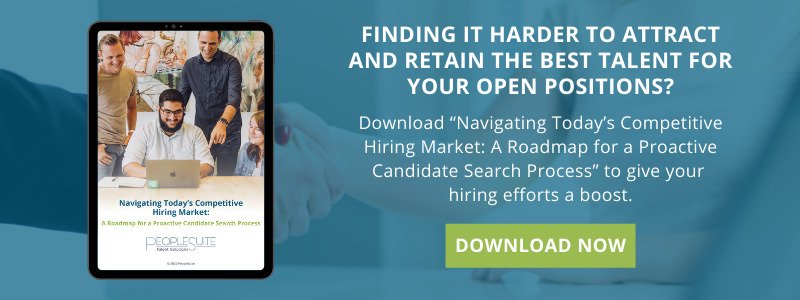There is still some resistance to diversity in the workplace—and not always due to a nefarious plot to keep certain people out. Most of the time, willful ignorance and lack of diversity recruiting strategy lead to homogenous workplaces filled with people that look and think the same way. You might think you are trying to be true to your workplace culture, when you are really missing out on the pieces that make a culture multi-faceted.
Companies with ethnically diverse leadership are 33% more likely to have above-average profits. Companies with gender-diverse leadership are 21% more likely to have higher profitability. The
report by McKinsey & Company notes, “Gender and ethnic diversity are clearly correlated with profitability, but women and minorities remain underrepresented.”
Is Unconscious Bias Impacting Your Workforce?
We ALL have bias and use it every day of our lives.
Bias occurs when someone is coming toward you on the street and you make a quick judgment call as to your safety and their intentions. Bias occurs no matter the color of skin—it can also be called a first impression. It’s important to realize that bias isn’t a dirty word. The more we understand it absolutely
does impact our processes, the more we can fight unfair biases that we don’t even realize we hold.
When someone comes in for a
job interview, you will immediately assess things, like clothing choices and posture. Perhaps you’ve noticed an interview where you thought someone looked like a great fit and then found out they just weren’t quite right for the role. That is a positive bias that had to be proven wrong. There is plenty of research that shows
attractive people are more likely to be hired. Appearance-based bias can make it harder for people who are obese, tattooed, older or oddly dressed to get a fair shot at the role.
And, skin color makes this even harder. While some candidates can change how they dress, a bias towards skin color is impossible to avoid. This can easily add a negative bias that has to be proven wrong in order to even get a shot. There is often an unconscious belief that
darker skin tones come with a higher proclivity toward violence, attitude, laziness and other unfair labels.
But, let’s say you
refuse to hold those negative labels. Could bias still impact you?
It’s important to note that intrinsic bias can also be held in what you expect from your candidate. You might be overlooking a great hire because you aren’t sure they will “fit the culture.” Maybe they are loud or show some very strong opinions during the interview. Maybe they wear
natural hairstyles, including dreadlocks, that don’t fit the professional mold you are after.
Let’s be blunt: holding everyone to white culture standards is just as damaging as refusing to hire due to color or race.
As Stanford Social Innovation Review notes in its article,
The Bias of ‘Professionalism’ Standards:
These values, established over time as history and fact, have been used to create the narrative of white supremacy that underpins professionalism today, playing out in the hiring, firing, and day-to-day management of workplaces around the world. The story unfolds many ways: in white and Western standards of dress and hairstyle (straightened hair, suits but not saris, and burqa and beard bans in some countries); in speech, accent, word choice, and communication (never show emotion, must sound “American,” and must speak white standard English); in scrutiny (black employees are monitored more closely and face more penalties as a result); and in attitudes toward timeliness and work style.
What is a Diversity Recruitment Strategy?
So, do you even have a diversity recruitment strategy? This is a roadmap that helps you purposely seek out diverse individuals who don’t necessarily fit the mold you already have in place. The strategy should include your goals and reasoning for hiring diverse individuals. It will include the methods you are using to attract and retain top talent in various minority groups.
The strategy will help you stay focused on diverse hiring practices that improve the variety in your workplace.
How to Create a Diverse Recruitment Strategy
The most important thing in your strategy will be to understand the “why” behind your diversity recruitment strategy. Be honest.
If you just want to make your workplace look better or you want to assuage your guilt, then you are not going to offer a fair chance to a minority talent.
One
reason for hiring more diversity might be to increase your perspective as a company. Another could be because you want to better reflect your community or customer base. If you don’t have a strong “why” backing your strategy, you are going to struggle to get the rest of your team on board and really address the issues holding you back.
Your strategy should note some common pitfalls that occur during the hiring process that can stunt diverse hiring processes. Some companies will check names or zip codes on the applications—a bias that often leads to avoiding people from certain neighborhoods or who have non-traditional (white) names.
Another common area that hurts diverse hiring is getting caught up in internships, awards or academic achievements listed on the resume. For example, someone from a low-income situation may not be able to afford taking a free internship and has to pass up the opportunity for a low-wage job to make ends meet. If you rely on free internships to bring in new talent for entry-level job offers, you may have to rethink your process for your diversity recruitment strategy because you are
shutting certain people out.
Finally, your diversity strategy should include getting your team on board with the new approach. You will have a hard time retaining diverse talent if your culture is geared toward white culture over inclusion. Many companies stop with one or two diversity hires and never change the problematic toxic culture that arose from years of a homogenous workforce.
7 Steps to Build a More Diverse Workforce
When creating your strategy, ask yourself:
How can I attract diverse candidates? Here are some ways to beef up your strategy to create a more inclusive recruiting process.
Make Your Site More Diverse
If you show a rainbow of colors, sizes and styles on your site, a person with top talent is going to feel more welcome to apply. Start by trying to show your intent. Don’t go over the top with fake stock photos, but make sure it’s naturally worked into the very fabric of your brand look.
Use Diverse Job Boards
There are a number of job boards that specialize in helping you find and attract a more diverse talent pool. A few of these include:
Pursue True Diversity
A diverse recruitment strategy doesn’t mean you just need to check off a box or two in regards to a gender or nationality hire. Diversity means bringing in a wide range of different people groups. This includes females and people of color (black, Asian, Hispanic, etc.). It also means recognizing that an African native will have a much different perspective and approach than a black American—despite a similar skin tone. And that Hispanic is a broad category that covers a variety of ethnic identities.
Establish Internships and Scholarships
If you really want to bring in top talent from certain groups, you can approach them with a hiring strategy built for success—offering real opportunity. Companies use scholarships, fellowships and internships to help attract top talent, and you can do the same—targeting top talent in diverse groups. This can give people from underrepresented groups a better shot at competing in the workforce for top entry-level positions.
Form a Diverse Interview Group
If possible, bring diversity into the hiring process. This helps catch unconscious bias you might have towards an individual because of their looks or unconventional approach. It can be helpful to undergo some unconscious bias training as well—helping you pinpoint negative bias that could impact recruitment.
Create Inclusive Workplace Policies
Before bringing on people from minority groups, it’s important to carefully comb your policies for areas that would be less fair to some groups than others. From dress codes that include hairstyles to your methods for reporting harassment—there are a number of ways policy could impact one group more than another. Make sure employees have a way to safely provide criticism or complaints (without blowback) if there are any issues.
Don’t Target Diversity Alone
Here is a complicated place where it might seem contradictory: you cannot hire for diversity alone. While there are a number of things that might look different (resume points, appearance, personality), it is detrimental to fill a role solely due to a desire for a diverse hire. You will only seed resentment in your team and put the hire in an unfair position.
There are millions of highly qualified minorities! Keep working on your diversity recruitment strategy until you find talented people from minority groups who can fill the role.
Think outside the box in terms of what you deem necessary for the role—but not so far outside of the box that you are hiring for skin color or gender alone.
Assessing Your Diversity Recruitment Strategy Over Time
Your diversity recruitment strategy should include your approach to attracting top talent from minority groups
and assess your company’s ability to retain those diverse hires.
It is a continual process to improve the strategy and reassess the approach.
Selecting diverse hires for executive positions should be the true measure of success.
Your company will not ever be truly diverse until the leadership reflects diversity. You may have diverse hires, but if they don’t have power within the company, it doesn’t mean a lot. Diversity is going to require different perspectives on
every level.
This is not something that happens by accident.
Changing a homogenous workplace into a diverse place of inclusion is going to take a strategy change and culture shift. The company culture will have to become more welcoming to perspectives that challenge the status quo. You will need to specifically seek out diverse talent to
fill an executive role.
This culture shift is a process that requires a system of checks and balances for internal accountability. It demands a change in culture and thinking on every level. If you are in a rut with your hiring process, you may want to seek outside help for a diverse strategy to get on track.
Build a Stronger Team with Diversity and Inclusion Jobs
If you want help with diverse hiring strategies, we can help. At PeopleSuite we help you bring in top leaders to fill executive positions. We also offer
HR consulting to help you audit your process and build a stronger recruitment strategy.
Ready to start your search?
Contact us today to find diverse and talented candidates for your team.
{{cta(‘5601ce47-f80b-4cea-bfb0-d110f4b3cf1a’)}}









